Uniform honeycombs in hyperbolic space
In hyperbolic geometry, a uniform honeycomb in hyperbolic space is a uniform tessellation of uniform polyhedral cells. In 3-dimensional hyperbolic space there are nine Coxeter group families of compact convex uniform honeycombs, generated as Wythoff constructions, and represented by permutations of rings of the Coxeter diagrams for each family.
| Unsolved problem in mathematics: Find the complete set of hyperbolic uniform honeycombs (more unsolved problems in mathematics) |
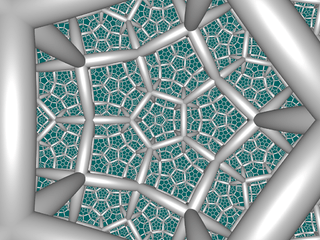 {5,3,4} |
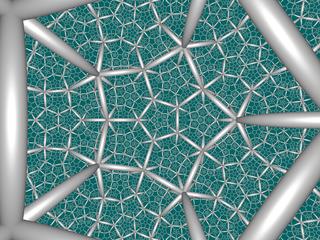 {5,3,5} |
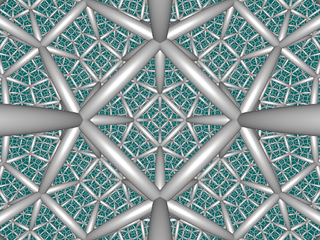 {4,3,5} |
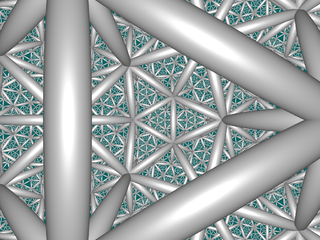 {3,5,3} |
| Poincaré ball model projections | |
|---|---|
Hyperbolic uniform honeycomb families
Honeycombs are divided between compact and paracompact forms defined by Coxeter groups, the first category only including finite cells and vertex figures (finite subgroups), and the second includes affine subgroups.
Compact uniform honeycomb families
The nine compact Coxeter groups are listed here with their Coxeter diagrams,[1] in order of the relative volumes of their fundamental simplex domains.[2]
These 9 families generate a total of 76 unique uniform honeycombs. The full list of hyperbolic uniform honeycombs has not been proven and an unknown number of non-Wythoffian forms exist. One known example is cited with the {3,5,3} family below. Only two families are related as a mirror-removal halving: [5,31,1] ↔ [5,3,4,1+].
| Indexed | Fundamental simplex volume[3] |
Witt symbol |
Coxeter notation |
Commutator subgroup |
Coxeter diagram |
Honeycombs |
|---|---|---|---|---|---|---|
| H1 | 0.0358850633 | [5,3,4] | [(5,3)+,4,1+] = [5,31,1]+ | 15 forms, 2 regular | ||
| H2 | 0.0390502856 | [3,5,3] | [3,5,3]+ | 9 forms, 1 regular | ||
| H3 | 0.0717701267 | [5,31,1] | [5,31,1]+ | 11 forms (7 overlap with [5,3,4] family, 4 are unique) | ||
| H4 | 0.0857701820 | [(4,3,3,3)] | [(4,3,3,3)]+ | 9 forms | ||
| H5 | 0.0933255395 | [5,3,5] | [5,3,5]+ | 9 forms, 1 regular | ||
| H6 | 0.2052887885 | [(5,3,3,3)] | [(5,3,3,3)]+ | 9 forms | ||
| H7 | 0.2222287320 | [(4,3)[2]] | [(4,3+,4,3+)] | 6 forms | ||
| H8 | 0.3586534401 | [(3,4,3,5)] | [(3,4,3,5)]+ | 9 forms | ||
| H9 | 0.5021308905 | [(5,3)[2]] | [(5,3)[2]]+ | 6 forms |
There are just two radical subgroups with nonsimplectic domains that can be generated by removing a set of two or more mirrors separated by all other mirrors by even-order branches. One is [(4,3,4,3*)], represented by Coxeter diagrams ![]()
![]()
![]()
![]()
![]()
![]()
![]()
![]()
![]()
![]()
![]()
![]()
![]()
![]()
![]()
![]()
Paracompact hyperbolic uniform honeycombs
There are also 23 paracompact Coxeter groups of rank 4 that produce paracompact uniform honeycombs with infinite or unbounded facets or vertex figure, including ideal vertices at infinity.
| Type | Coxeter groups |
|---|---|
| Linear graphs | |
| Tridental graphs | |
| Cyclic graphs | |
| Loop-n-tail graphs |
Other paracompact Coxeter groups exists as Vinberg polytope fundamental domains, including these triangular bipyramid fundamental domains (double tetrahedra) as rank 5 graphs including parallel mirrors. Uniform honeycombs exist as all permutations of rings in these graphs, with the constraint that at least one node must be ringed across infinite order branches.
| Dimension | Rank | Graphs |
|---|---|---|
| H3 | 5 |
|
[3,5,3] family
There are 9 forms, generated by ring permutations of the Coxeter group: [3,5,3] or ![]()
![]()
![]()
![]()
![]()
![]()
![]()
One related non-wythoffian form is constructed from the {3,5,3} vertex figure with 4 (tetrahedrally arranged) vertices removed, creating pentagonal antiprisms and dodecahedra filling in the gaps, called a tetrahedrally diminished dodecahedron.[4]
The bitruncated and runcinated forms (5 and 6) contain the faces of two regular skew polyhedrons: {4,10|3} and {10,4|3}.
| # | Honeycomb name Coxeter diagram and Schläfli symbols |
Cell counts/vertex and positions in honeycomb |
Vertex figure | Picture | |||
|---|---|---|---|---|---|---|---|
| 0 |
1 |
2 |
3 | ||||
| 1 | icosahedral t0{3,5,3} |
(12) (3.3.3.3.3) |
 |
 | |||
| 2 | rectified icosahedral t1{3,5,3} |
(2) (5.5.5) |
(3) (3.5.3.5) |
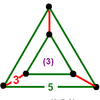 |
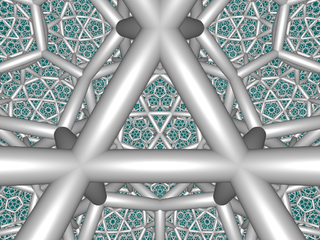 | ||
| 3 | truncated icosahedral t0,1{3,5,3} |
(1) (5.5.5) |
(3) (5.6.6) |
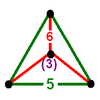 |
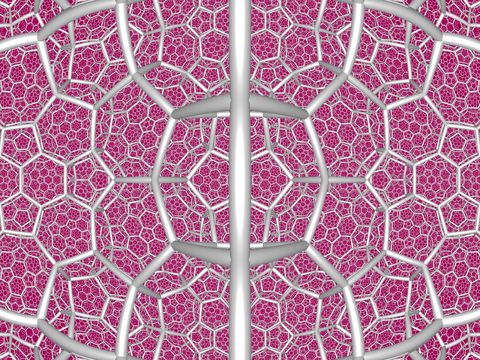 | ||
| 4 | cantellated icosahedral t0,2{3,5,3} |
(1) (3.5.3.5) |
(2) (4.4.3) |
(2) (3.5.4.5) |
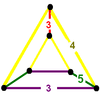 |
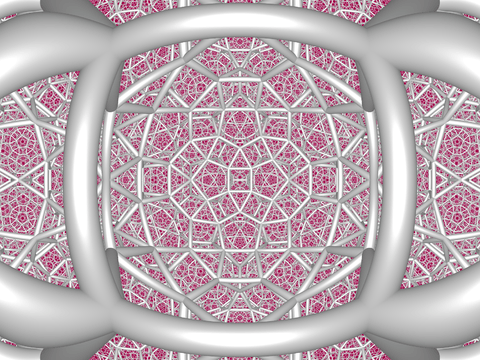 | |
| 5 | runcinated icosahedral t0,3{3,5,3} |
(1) (3.3.3.3.3) |
(5) (4.4.3) |
(5) (4.4.3) |
(1) (3.3.3.3.3) |
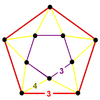 |
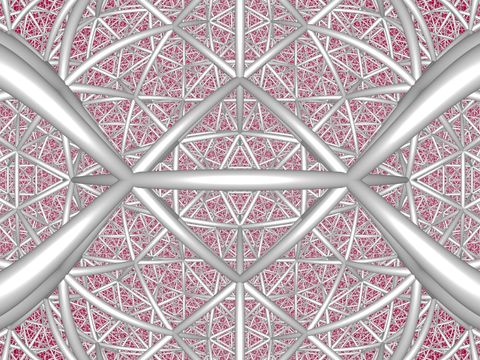 |
| 6 | bitruncated icosahedral t1,2{3,5,3} |
(2) (3.10.10) |
(2) (3.10.10) |
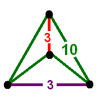 |
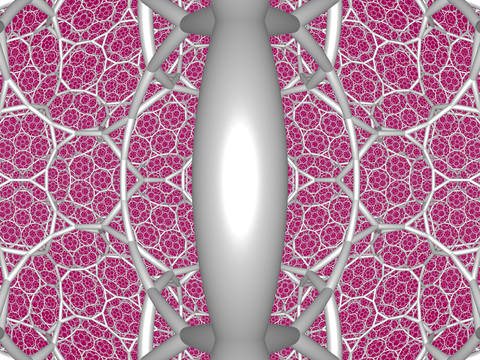 | ||
| 7 | cantitruncated icosahedral t0,1,2{3,5,3} |
(1) (3.10.10) |
(1) (4.4.3) |
(2) (4.6.10) |
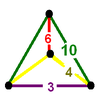 |
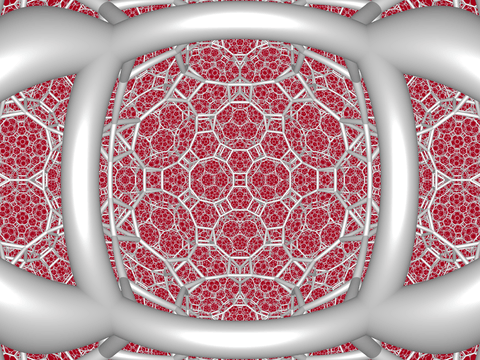 | |
| 8 | runcitruncated icosahedral t0,1,3{3,5,3} |
(1) (3.5.4.5) |
(1) (4.4.3) |
(2) (4.4.6) |
(1) (5.6.6) |
 |
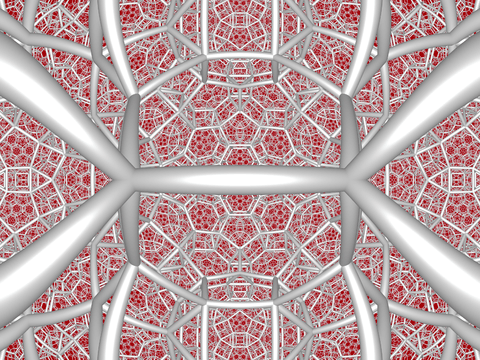 |
| 9 | omnitruncated icosahedral t0,1,2,3{3,5,3} |
(1) (4.6.10) |
(1) (4.4.6) |
(1) (4.4.6) |
(1) (4.6.10) |
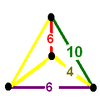 |
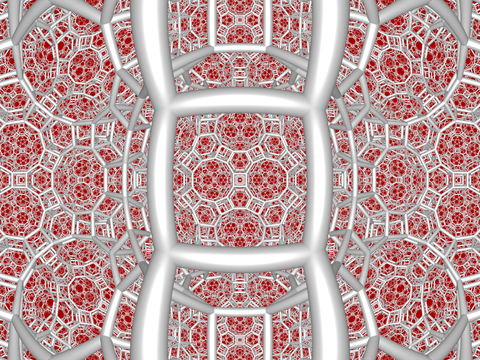 |
| # | Honeycomb name Coxeter diagram and Schläfli symbols |
Cell counts/vertex and positions in honeycomb |
Vertex figure | Picture | ||||
|---|---|---|---|---|---|---|---|---|
| 0 |
1 |
2 |
3 |
Alt | ||||
| [77] | partially diminished icosahedral pd{3,5,3}[5] |
(12) (3.3.3.5) |
(4) (5.5.5) |
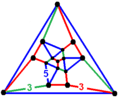 |
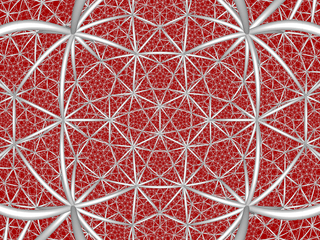 | |||
| Nonuniform | omnisnub icosahedral ht0,1,2,3{3,5,3} |
(1) (3.3.3.3.5) |
(1) (3.3.3.3 |
(1) (3.3.3.3) |
(1) (3.3.3.3.5) |
(4) +(3.3.3) |
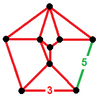 |
|
[5,3,4] family
There are 15 forms, generated by ring permutations of the Coxeter group: [5,3,4] or ![]()
![]()
![]()
![]()
![]()
![]()
![]()
This family is related to the group [5,31,1] by a half symmetry [5,3,4,1+], or ![]()
![]()
![]()
![]()
![]()
![]()
![]()
![]()
![]()
![]()
![]()
![]()
![]()
![]()
![]()
![]()
![]()
![]()
![]()
![]()
![]()
![]()
![]()
![]()
| # | Name of honeycomb Coxeter diagram |
Cells by location and count per vertex | Vertex figure | Picture | |||
|---|---|---|---|---|---|---|---|
| 0 |
1 |
2 |
3 | ||||
| 10 | order-4 dodecahedral |
- | - | - | (8) (5.5.5) |
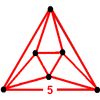 |
 |
| 11 | rectified order-4 dodecahedral |
(2) (3.3.3.3) |
- | - | (4) (3.5.3.5) |
 |
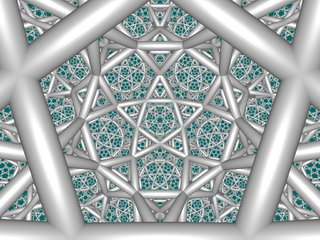 |
| 12 | rectified order-5 cubic |
(5) (3.4.3.4) |
- | - | (2) (3.3.3.3.3) |
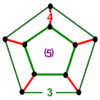 |
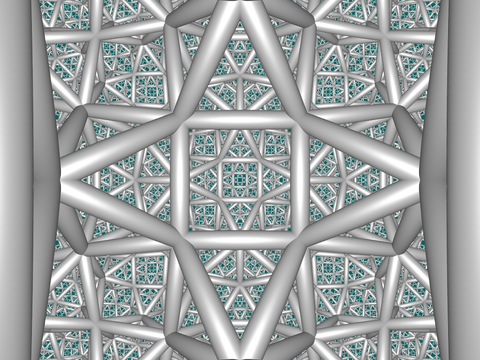 |
| 13 | order-5 cubic |
(20) (4.4.4) |
- | - | - |  |
 |
| 14 | truncated order-4 dodecahedral |
(1) (3.3.3.3) |
- | - | (4) (3.10.10) |
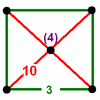 |
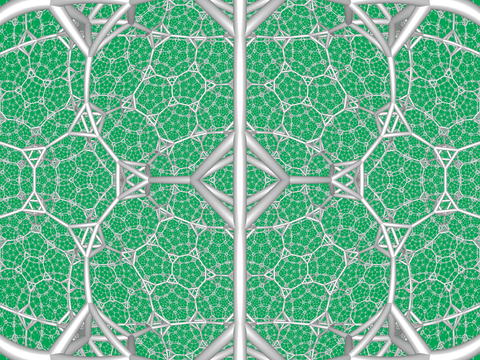 |
| 15 | bitruncated order-5 cubic |
(2) (4.6.6) |
- | - | (2) (5.6.6) |
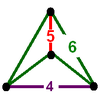 |
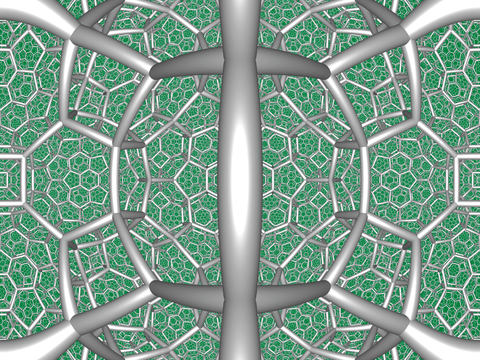 |
| 16 | truncated order-5 cubic |
(5) (3.8.8) |
- | - | (1) (3.3.3.3.3) |
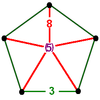 |
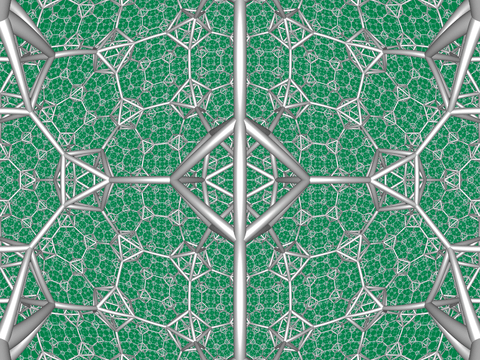 |
| 17 | cantellated order-4 dodecahedral |
(1) (3.4.3.4) |
(2) (4.4.4) |
- | (2) (3.4.5.4) |
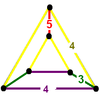 |
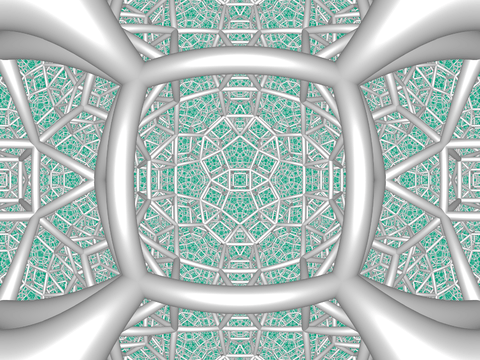 |
| 18 | cantellated order-5 cubic |
(2) (3.4.4.4) |
- | (2) (4.4.5) |
(1) (3.5.3.5) |
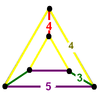 |
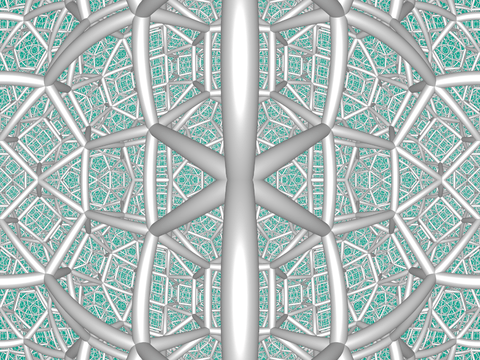 |
| 19 | runcinated order-5 cubic |
(1) (4.4.4) |
(3) (4.4.4) |
(3) (4.4.5) |
(1) (5.5.5) |
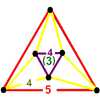 |
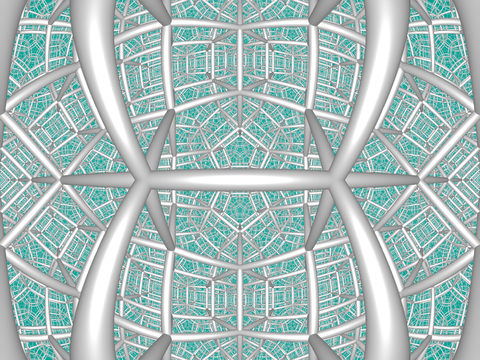 |
| 20 | cantitruncated order-4 dodecahedral |
(1) (4.6.6) |
(1) (4.4.4) |
- | (2) (4.6.10) |
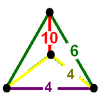 |
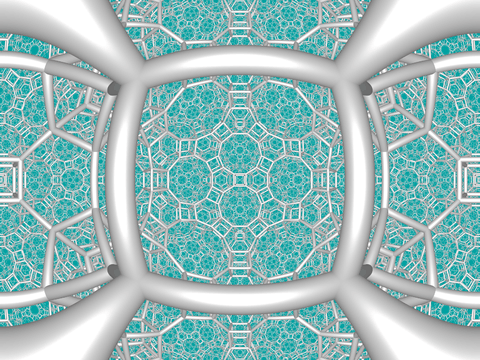 |
| 21 | cantitruncated order-5 cubic |
(2) (4.6.8) |
- | (1) (4.4.5) |
(1) (5.6.6) |
 |
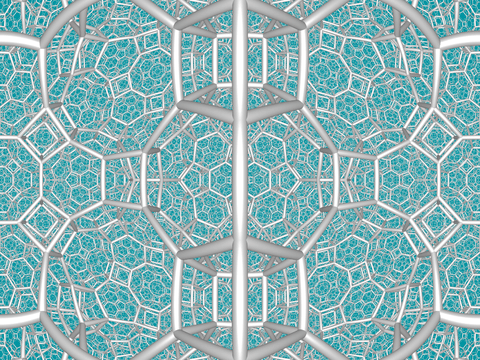 |
| 22 | runcitruncated order-4 dodecahedral |
(1) (3.4.4.4) |
(1) (4.4.4) |
(2) (4.4.10) |
(1) (3.10.10) |
 |
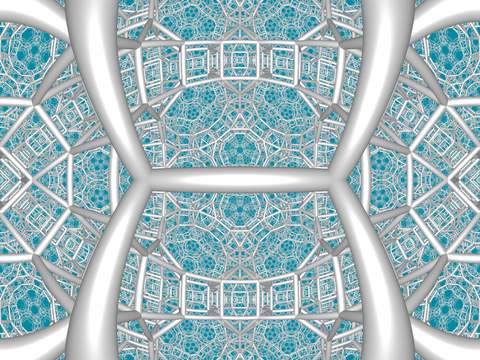 |
| 23 | runcitruncated order-5 cubic |
(1) (3.8.8) |
(2) (4.4.8) |
(1) (4.4.5) |
(1) (3.4.5.4) |
 |
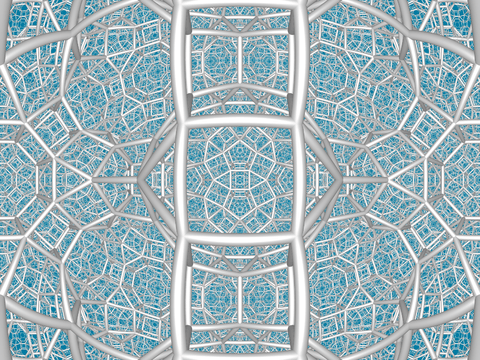 |
| 24 | omnitruncated order-5 cubic |
(1) (4.6.8) |
(1) (4.4.8) |
(1) (4.4.10) |
(1) (4.6.10) |
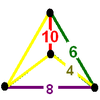 |
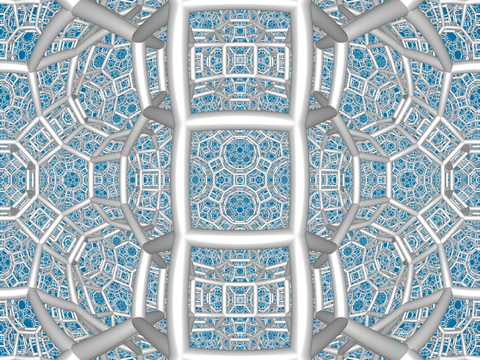 |
| # | Name of honeycomb Coxeter diagram |
Cells by location and count per vertex | Vertex figure | Picture | |||||
|---|---|---|---|---|---|---|---|---|---|
| 0 |
1 |
2 |
3 |
Alt | |||||
| [34] | alternated order-5 cubic |
(20) (3.3.3) |
(12) (3.3.3.3.3) |
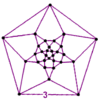 |
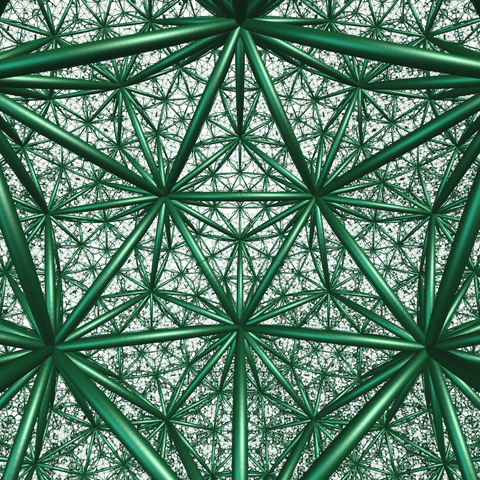 | ||||
| [35] | cantic order-5 cubic |
(1) (3.5.3.5) |
- | (2) (5.6.6) |
(2) (3.6.6) |
 |
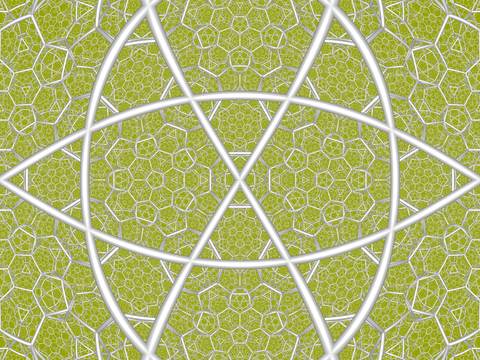 |
||
| [36] | runcic order-5 cubic |
(1) (5.5.5) |
- | (3) (3.4.5.4) |
(1) (3.3.3) |
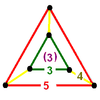 |
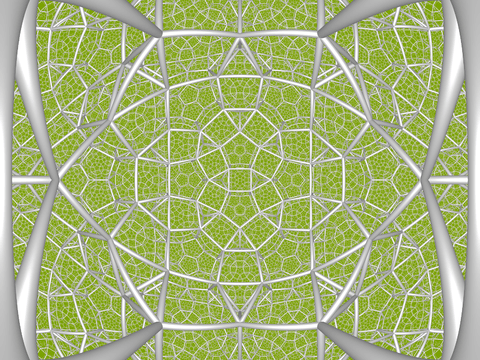 |
||
| [37] | runcicantic order-5 cubic |
(1) (3.10.10) |
- | (2) (4.6.10) |
(1) (3.6.6) |
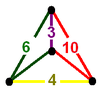 |
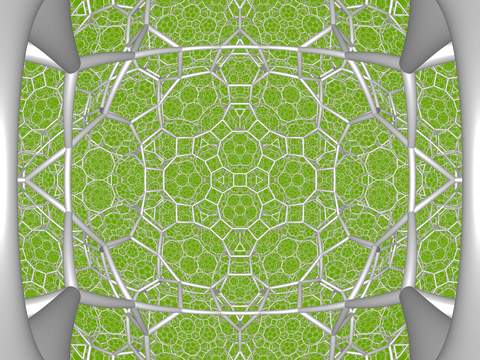 |
||
| Nonuniform | snub rectified order-4 dodecahedral |
(1) (3.3.3.3.3) |
(1) (3.3.3) |
- | (2) (3.3.3.3.5) |
(4) +(3.3.3) |
 Irr. tridiminished icosahedron |
||
| Nonuniform | runcic snub rectified order-4 dodecahedral |
(3.4.4.4) |
(4.4.4.4) |
- | (3.3.3.3.5) |
+(3.3.3) |
|||
| Nonuniform | omnisnub order-5 cubic |
(1) (3.3.3.3.4) |
(1) (3.3.3.4) |
(1) (3.3.3.5) |
(1) (3.3.3.3.5) |
(4) +(3.3.3) |
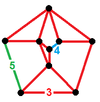 |
||
[5,3,5] family
There are 9 forms, generated by ring permutations of the Coxeter group: [5,3,5] or ![]()
![]()
![]()
![]()
![]()
![]()
![]()
The bitruncated and runcinated forms (29 and 30) contain the faces of two regular skew polyhedrons: {4,6|5} and {6,4|5}.
| # | Name of honeycomb Coxeter diagram |
Cells by location and count per vertex | Vertex figure | Picture | |||
|---|---|---|---|---|---|---|---|
| 0 |
1 |
2 |
3 | ||||
| 25 | (Regular) Order-5 dodecahedral t0{5,3,5} |
(20) (5.5.5) |
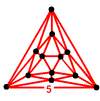 |
 | |||
| 26 | rectified order-5 dodecahedral t1{5,3,5} |
(2) (3.3.3.3.3) |
(5) (3.5.3.5) |
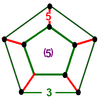 |
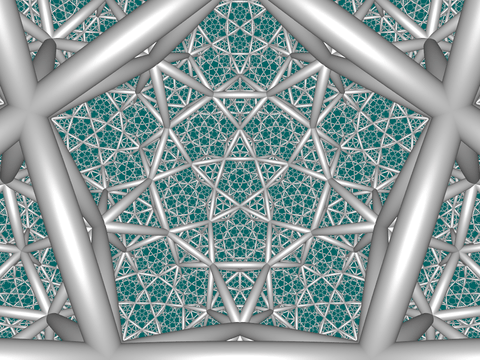 | ||
| 27 | truncated order-5 dodecahedral t0,1{5,3,5} |
(1) (3.3.3.3.3) |
(5) (3.10.10) |
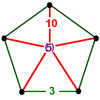 |
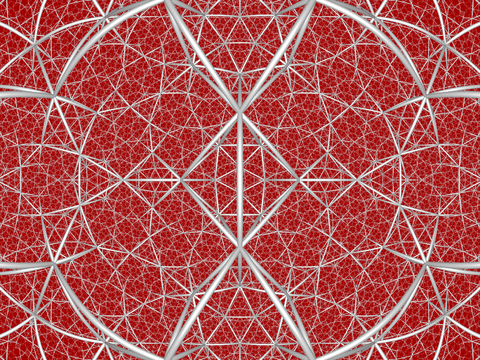 | ||
| 28 | cantellated order-5 dodecahedral t0,2{5,3,5} |
(1) (3.5.3.5) |
(2) (4.4.5) |
(2) (3.5.4.5) |
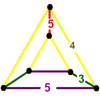 |
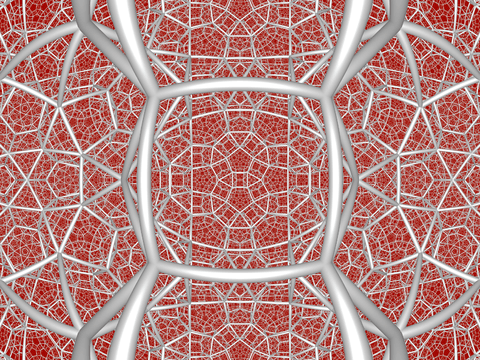 | |
| 29 | Runcinated order-5 dodecahedral t0,3{5,3,5} |
(1) (5.5.5) |
(3) (4.4.5) |
(3) (4.4.5) |
(1) (5.5.5) |
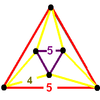 |
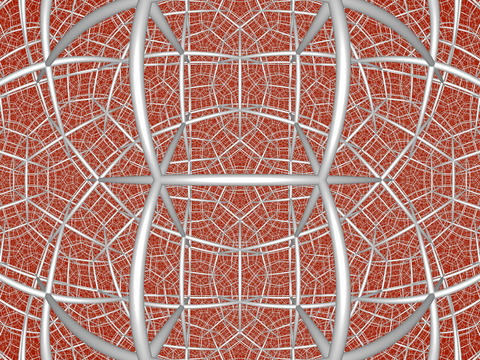 |
| 30 | bitruncated order-5 dodecahedral t1,2{5,3,5} |
(2) (5.6.6) |
(2) (5.6.6) |
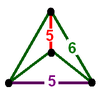 |
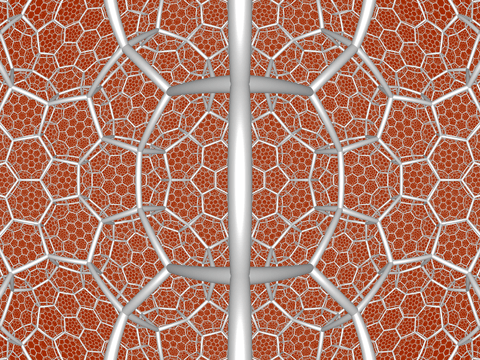 | ||
| 31 | cantitruncated order-5 dodecahedral t0,1,2{5,3,5} |
(1) (5.6.6) |
(1) (4.4.5) |
(2) (4.6.10) |
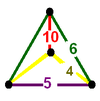 |
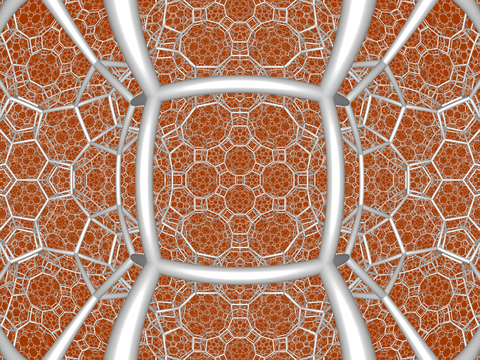 | |
| 32 | runcitruncated order-5 dodecahedral t0,1,3{5,3,5} |
(1) (3.5.4.5) |
(1) (4.4.5) |
(2) (4.4.10) |
(1) (3.10.10) |
 |
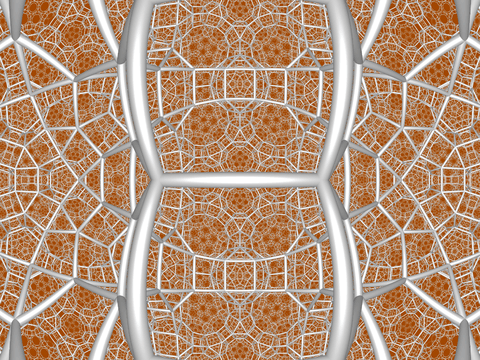 |
| 33 | omnitruncated order-5 dodecahedral t0,1,2,3{5,3,5} |
(1) (4.6.10) |
(1) (4.4.10) |
(1) (4.4.10) |
(1) (4.6.10) |
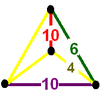 |
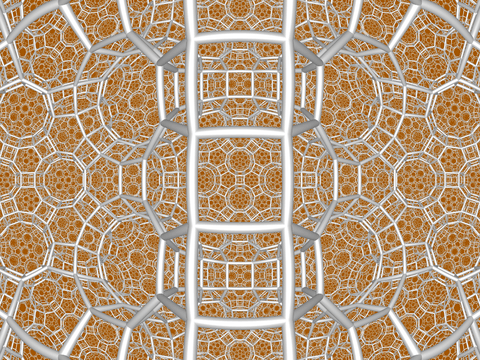 |
| # | Name of honeycomb Coxeter diagram |
Cells by location and count per vertex | Vertex figure | Picture | ||||
|---|---|---|---|---|---|---|---|---|
| 0 |
1 |
2 |
3 |
Alt | ||||
| Nonuniform | omnisnub order-5 dodecahedral ht0,1,2,3{5,3,5} |
(1) (3.3.3.3.5) |
(1) (3.3.3.5) |
(1) (3.3.3.5) |
(1) (3.3.3.3.5) |
(4) +(3.3.3) |
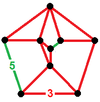 |
|
[5,31,1] family
There are 11 forms (and only 4 not shared with [5,3,4] family), generated by ring permutations of the Coxeter group: [5,31,1] or ![]()
![]()
![]()
![]()
![]()
![]()
![]()
![]()
![]()
![]()
![]()
![]()
![]()
![]()
![]()
![]()
![]()
| # | Honeycomb name Coxeter diagram |
Cells by location (and count around each vertex) |
vertex figure | Picture | |||
|---|---|---|---|---|---|---|---|
| 0 |
1 |
0' |
3 | ||||
| 34 | alternated order-5 cubic |
- | - | (12) (3.3.3.3.3) |
(20) (3.3.3) |
 |
 |
| 35 | cantic order-5 cubic |
(1) (3.5.3.5) |
- | (2) (5.6.6) |
(2) (3.6.6) |
 |
 |
| 36 | runcic order-5 cubic |
(1) (5.5.5) |
- | (3) (3.4.5.4) |
(1) (3.3.3) |
 |
 |
| 37 | runcicantic order-5 cubic |
(1) (3.10.10) |
- | (2) (4.6.10) |
(1) (3.6.6) |
 |
 |
| # | Honeycomb name Coxeter diagram |
Cells by location (and count around each vertex) |
vertex figure | Picture | |||
|---|---|---|---|---|---|---|---|
| 0 |
1 |
3 |
Alt | ||||
| [10] | Order-4 dodecahedral |
(4) (5.5.5) |
- | - |  |
 | |
| [11] | rectified order-4 dodecahedral |
(2) (3.5.3.5) |
- | (2) (3.3.3.3) |
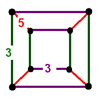 |
 | |
| [12] | rectified order-5 cubic |
(1) (3.3.3.3.3) |
- | (5) (3.4.3.4) |
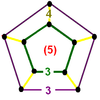 |
 | |
| [15] | bitruncated order-5 cubic |
(1) (5.6.6) |
- | (2) (4.6.6) |
 |
 | |
| [14] | truncated order-4 dodecahedral |
(2) (3.10.10) |
- | (1) (3.3.3.3) |
 |
 | |
| [17] | cantellated order-4 dodecahedral |
(1) (3.4.5.4) |
(2) (4.4.4) |
(1) (3.4.3.4) |
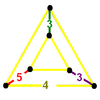 |
 | |
| [20] | cantitruncated order-4 dodecahedral |
(1) (4.6.10) |
(1) (4.4.4) |
(1) (4.6.6) |
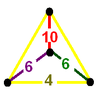 |
 | |
| Nonuniform | snub rectified order-4 dodecahedral |
(2) (3.3.3.3.5) |
(1) (3.3.3) |
(2) (3.3.3.3.3) |
(4) +(3.3.3) |
 Irr. tridiminished icosahedron | |
[(4,3,3,3)] family
There are 9 forms, generated by ring permutations of the Coxeter group: ![]()
![]()
![]()
![]()
The bitruncated and runcinated forms (41 and 42) contain the faces of two regular skew polyhedrons: {8,6|3} and {6,8|3}.
| # | Honeycomb name Coxeter diagram |
Cells by location (and count around each vertex) |
vertex figure | Picture | ||||
|---|---|---|---|---|---|---|---|---|
| 0 |
1 |
2 |
3 |
Alt | ||||
| 38 | tetrahedral-cubic {(3,3,3,4)} |
(4) (3.3.3) |
- | (4) (4.4.4) |
(6) (3.4.3.4) |
 |
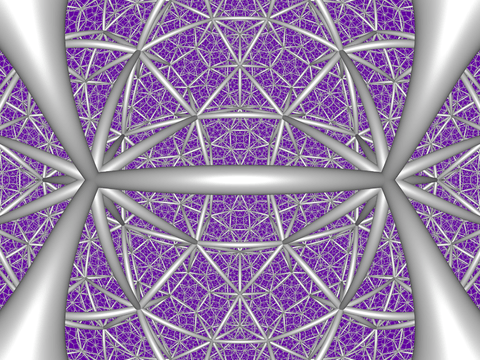 | |
| 39 | tetrahedral-octahedral {(3,3,4,3)} |
(12) (3.3.3.3) |
(8) (3.3.3) |
- | (8) (3.3.3.3) |
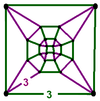 |
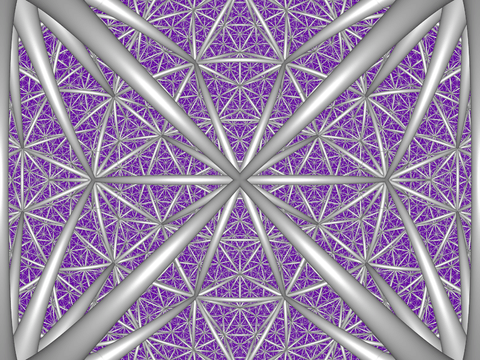 | |
| 40 | cyclotruncated tetrahedral-cubic ct{(3,3,3,4)} |
(3) (3.6.6) | (1) (3.3.3) |
(1) (4.4.4) |
(3) (4.6.6) |
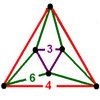 |
 | |
| 41 | cyclotruncated cube-tetrahedron ct{(4,3,3,3)} |
(1) (3.3.3) |
(1) (3.3.3) |
(3) (3.8.8) |
(3) (3.8.8) |
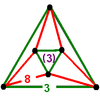 |
 | |
| 42 | cyclotruncated tetrahedral-octahedral ct{(3,3,4,3)} |
(4) (3.6.6) |
(4) (3.6.6) |
(1) (3.3.3.3) |
(1) (3.3.3.3) |
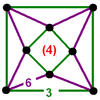 |
 | |
| 43 | rectified tetrahedral-cubic r{(3,3,3,4)} |
(1) (3.3.3.3) |
(2) (3.4.3.4) |
(1) (3.4.3.4) |
(2) (3.4.4.4) |
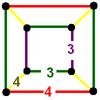 |
 | |
| 44 | truncated tetrahedral-cubic t{(3,3,3,4)} |
(1) (3.6.6) |
(1) (3.4.3.4) |
(1) (3.8.8) |
(2) (4.6.8) |
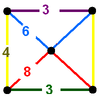 |
 | |
| 45 | truncated tetrahedral-octahedral t{(3,3,4,3)} |
(2) (4.6.6) |
(1) (3.6.6) |
(1) (3.4.4.4) |
(1) (4.6.6) |
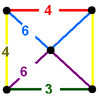 |
 | |
| 46 | omnitruncated tetrahedral-cubic tr{(3,3,3,4)} |
(1) (4.6.6) |
(1) (4.6.6) |
(1) (4.6.8) |
(1) (4.6.8) |
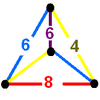 |
 | |
| Nonuniform | omnisnub tetrahedral-cubic sr{(3,3,3,4)} |
(1) (3.3.3.3.3) |
(1) (3.3.3.3.3) |
(1) (3.3.3.3.4) |
(1) (3.3.3.3.4) |
(4) +(3.3.3) |
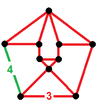 | |
[(5,3,3,3)] family
There are 9 forms, generated by ring permutations of the Coxeter group: ![]()
![]()
![]()
![]()
The bitruncated and runcinated forms (50 and 51) contain the faces of two regular skew polyhedrons: {10,6|3} and {6,10|3}.
| # | Honeycomb name Coxeter diagram |
Cells by location (and count around each vertex) |
vertex figure | Picture | |||
|---|---|---|---|---|---|---|---|
| 0 |
1 |
2 |
3 | ||||
| 47 | tetrahedral-dodecahedral |
(4) (3.3.3) |
- | (4) (5.5.5) |
(6) (3.5.3.5) |
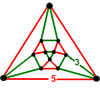 |
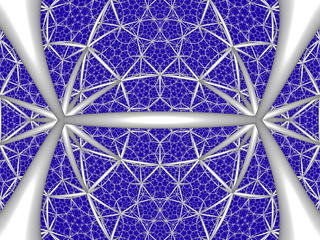 |
| 48 | tetrahedral-icosahedral |
(30) (3.3.3.3) |
(20) (3.3.3) |
- | (12) (3.3.3.3.3) |
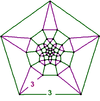 |
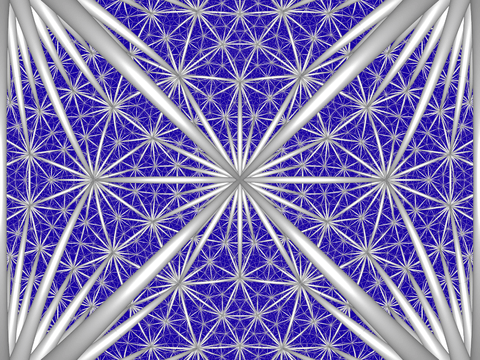 |
| 49 | cyclotruncated tetrahedral-dodecahedral |
(3) (3.6.6) |
(1) (3.3.3) |
(1) (5.5.5) |
(3) (5.6.6) |
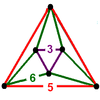 |
 |
| 52 | rectified tetrahedral-dodecahedral |
(1) (3.3.3.3) |
(2) (3.4.3.4) |
(1) (3.5.3.5) |
(2) (3.4.5.4) |
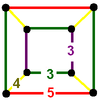 |
 |
| 53 | truncated tetrahedral-dodecahedral |
(1) (3.6.6) |
(1) (3.4.3.4) |
(1) (3.10.10) |
(2) (4.6.10) |
 |
 |
| 54 | truncated tetrahedral-icosahedral |
(2) (4.6.6) |
(1) (3.6.6) |
(1) (3.4.5.4) |
(1) (5.6.6) |
 |
 |
| # | Honeycomb name Coxeter diagram |
Cells by location (and count around each vertex) |
vertex figure | Picture | ||
|---|---|---|---|---|---|---|
| 0,1 |
2,3 |
Alt | ||||
| 50 | cyclotruncated dodecahedral-tetrahedral |
(2) (3.3.3) |
(6) (3.10.10) |
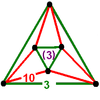 |
 | |
| 51 | cyclotruncated tetrahedral-icosahedral |
(10) (3.6.6) |
(2) (3.3.3.3.3) |
 |
 | |
| 55 | omnitruncated tetrahedral-dodecahedral |
(2) (4.6.6) |
(2) (4.6.10) |
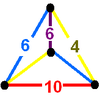 |
 | |
| Nonuniform | omnisnub tetrahedral-dodecahedral |
(2) (3.3.3.3.3) |
(2) (3.3.3.3.5) |
(4) +(3.3.3) |
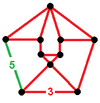 | |
[(4,3,4,3)] family
There are 6 forms, generated by ring permutations of the Coxeter group: ![]()
![]()
![]()
![]()
![]()
![]()
![]()
![]()
![]()
![]()
![]()
![]()
![]()
![]()
![]()
![]()
![]()
![]()
![]()
![]()
![]()
![]()
![]()
![]()
![]()
This symmetry family is also related to a radical subgroup, index 6, ![]()
![]()
![]()
![]()
![]()
![]()
![]()
![]()
![]()
![]()
![]()
The truncated forms (57 and 58) contain the faces of two regular skew polyhedrons: {6,6|4} and {8,8|3}.
| # | Honeycomb name Coxeter diagram |
Cells by location (and count around each vertex) |
vertex figure | Pictures | |||
|---|---|---|---|---|---|---|---|
| 0 |
1 |
2 |
3 | ||||
| 56 | cubic-octahedral |
(6) (3.3.3.3) |
- | (8) (4.4.4) |
(12) (3.4.3.4) |
 |
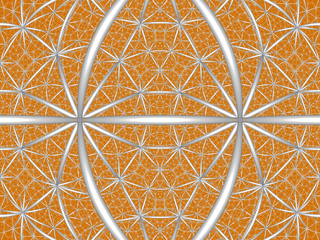 |
| 60 | truncated cubic-octahedral |
(1) (4.6.6) |
(1) (3.4.4.4) |
(1) (3.8.8) |
(2) (4.6.8) |
 |
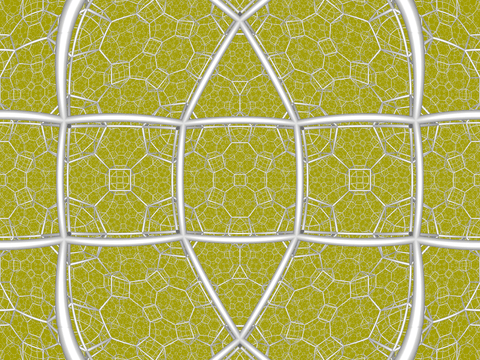 |
| # | Honeycomb name Coxeter diagram |
Cells by location (and count around each vertex) |
vertex figure | Picture | ||
|---|---|---|---|---|---|---|
| 0,3 |
1,2 |
Alt | ||||
| 57 | cyclotruncated octahedral-cubic |
(6) (4.6.6) |
(2) (4.4.4) |
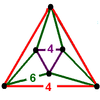 |
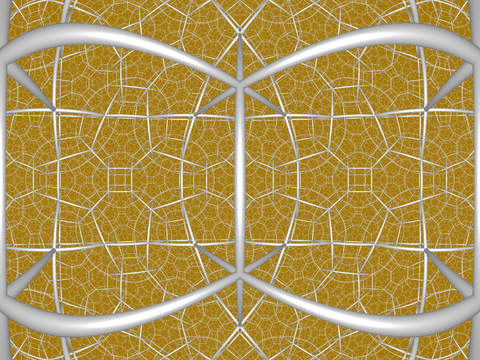 | |
| Nonuniform | cyclosnub octahedral-cubic |
(4) (3.3.3.3.3) |
(2) (3.3.3) |
(4) +(3.3.3.3) |
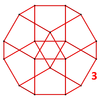 |
|
| # | Honeycomb name Coxeter diagram |
Cells by location (and count around each vertex) |
vertex figure | Picture | |
|---|---|---|---|---|---|
| 0,1 |
2,3 | ||||
| 58 | cyclotruncated cubic-octahedral |
(2) (3.3.3.3) |
(6) (3.8.8) |
 |
 |
| # | Honeycomb name Coxeter diagram |
Cells by location (and count around each vertex) |
vertex figure | Picture | |
|---|---|---|---|---|---|
| 0,2 |
1,3 | ||||
| 59 | rectified cubic-octahedral |
(2) (3.4.3.4) |
(4) (3.4.4.4) |
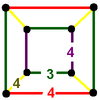 |
 |
| # | Honeycomb name Coxeter diagram |
Cells by location (and count around each vertex) |
vertex figure | Picture | |
|---|---|---|---|---|---|
| 0,1,2,3 |
Alt | ||||
| 61 | omnitruncated cubic-octahedral |
(4) (4.6.8) |
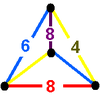 |
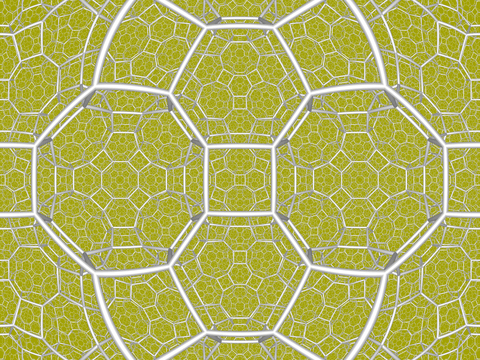 | |
| Nonuniform | omnisnub cubic-octahedral |
(4) (3.3.3.3.4) |
(4) +(3.3.3) |
 |
|
[(4,3,5,3)] family
There are 9 forms, generated by ring permutations of the Coxeter group: ![]()
![]()
![]()
![]()
![]()
The truncated forms (65 and 66) contain the faces of two regular skew polyhedrons: {10,6|3} and {6,10|3}.
| # | Honeycomb name Coxeter diagram |
Cells by location (and count around each vertex) |
vertex figure | Picture | |||
|---|---|---|---|---|---|---|---|
| 0 |
1 |
2 |
3 | ||||
| 62 | octahedral-dodecahedral |
(6) (3.3.3.3) |
- | (8) (5.5.5) |
(1) (3.5.3.5) |
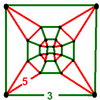 |
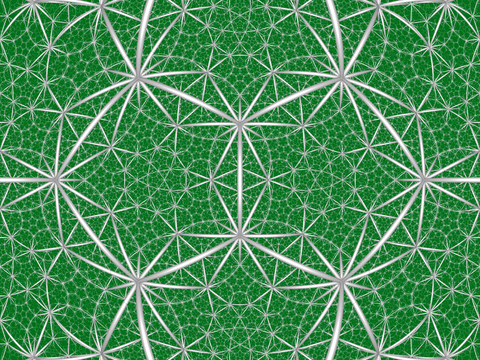 |
| 63 | cubic-icosahedral |
(30) (3.4.3.4) |
(20) (4.4.4) |
- | (12) (3.3.3.3.3) |
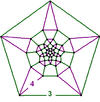 |
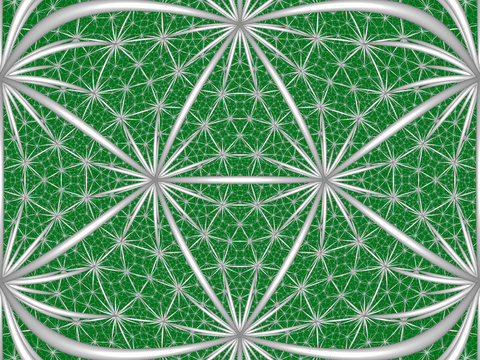 |
| 64 | cyclotruncated octahedral-dodecahedral |
(3) (4.6.6) |
(1) (4.4.4) |
(1) (5.5.5) |
(3) (5.6.6) |
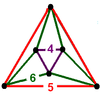 |
 |
| 67 | rectified octahedral-dodecahedral |
(1) (3.4.3.4) |
(2) (3.4.4.4) |
(1) (3.5.3.5) |
(2) (3.4.5.4) |
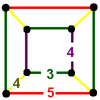 |
 |
| 68 | truncated octahedral-dodecahedral |
(1) (4.6.6) |
(1) (3.4.4.4) |
(1) (3.10.10) |
(2) (4.6.10) |
 |
 |
| 69 | truncated cubic-dodecahedral |
(2) (4.6.8) |
(1) (3.8.8) |
(1) (3.4.5.4) |
(1) (5.6.6) |
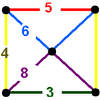 |
 |
| # | Honeycomb name Coxeter diagram |
Cells by location (and count around each vertex) |
vertex figure | Picture | ||
|---|---|---|---|---|---|---|
| 0,1 |
2,3 |
Alt | ||||
| 65 | cyclotruncated dodecahedral-octahedral |
(2) (3.3.3.3) |
(8) (3.10.10) |
 |
 | |
| 66 | cyclotruncated cubic-icosahedral |
(10) (3.8.8) |
(2) (3.3.3.3.3) |
 |
 | |
| 70 | omnitruncated octahedral-dodecahedral |
(2) (4.6.8) |
(2) (4.6.10) |
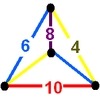 |
 | |
| Nonuniform | omnisnub octahedral-dodecahedral |
(2) (3.3.3.3.4) |
(2) (3.3.3.3.5) |
(4) +(3.3.3) |
 | |
[(5,3,5,3)] family
There are 6 forms, generated by ring permutations of the Coxeter group: ![]()
![]()
![]()
![]()
![]()
![]()
![]()
![]()
![]()
![]()
![]()
![]()
![]()
![]()
![]()
![]()
![]()
![]()
![]()
![]()
![]()
![]()
![]()
![]()
![]()
The truncated forms (72 and 73) contain the faces of two regular skew polyhedrons: {6,6|5} and {10,10|3}.
| # | Honeycomb name Coxeter diagram |
Cells by location (and count around each vertex) |
vertex figure | Picture | ||||
|---|---|---|---|---|---|---|---|---|
| 0 |
1 |
2 |
3 |
Alt | ||||
| 71 | dodecahedral-icosahedral |
(12) (3.3.3.3.3) |
- | (20) (5.5.5) |
(30) (3.5.3.5) |
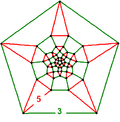 |
 | |
| 72 | cyclotruncated icosahedral-dodecahedral |
(3) (5.6.6) |
(1) (5.5.5) |
(1) (5.5.5) |
(3) (5.6.6) |
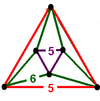 |
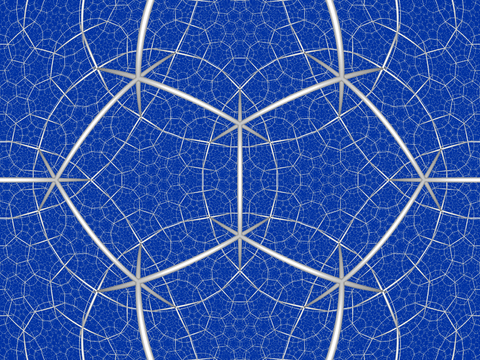 | |
| 73 | cyclotruncated dodecahedral-icosahedral |
(1) (3.3.3.3.3) |
(1) (3.3.3.3.3) |
(3) (3.10.10) |
(3) (3.10.10) |
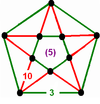 |
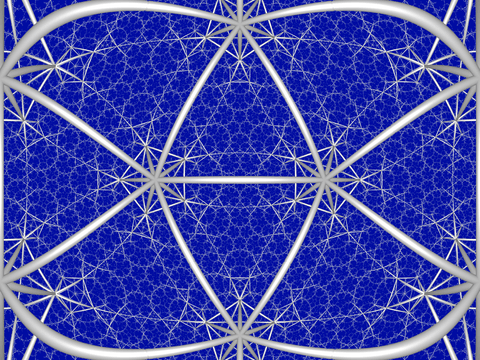 | |
| 74 | rectified dodecahedral-icosahedral |
(1) (3.5.3.5) |
(2) (3.4.5.4) |
(1) (3.5.3.5) |
(2) (3.4.5.4) |
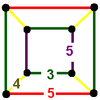 |
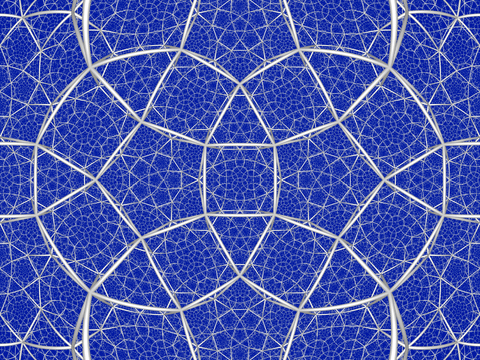 | |
| 75 | truncated dodecahedral-icosahedral |
(1) (5.6.6) |
(1) (3.4.5.4) |
(1) (3.10.10) |
(2) (4.6.10) |
 |
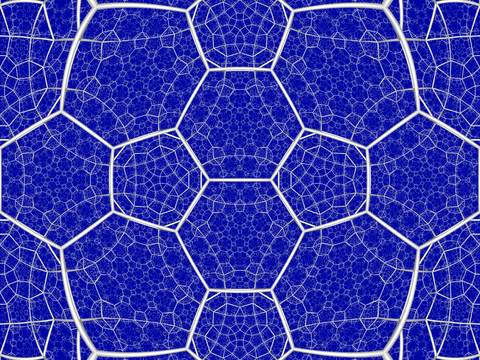 | |
| 76 | omnitruncated dodecahedral-icosahedral |
(1) (4.6.10) |
(1) (4.6.10) |
(1) (4.6.10) |
(1) (4.6.10) |
 |
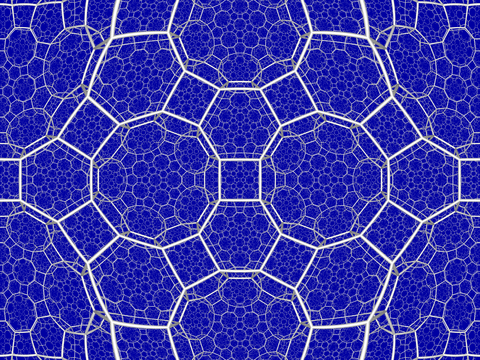 | |
| Nonuniform | omnisnub dodecahedral-icosahedral |
(1) (3.3.3.3.5) |
(1) (3.3.3.3.5) |
(1) (3.3.3.3.5) |
(1) (3.3.3.3.5) |
(4) +(3.3.3) |
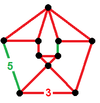 | |
Summary enumeration of compact uniform honeycombs
This is the complete enumeration of the 76 Wythoffian uniform honeycombs. The alternations are listed for completeness, but most are non-uniform.
| Index | Coxeter group | Extended symmetry |
Honeycombs | Chiral extended symmetry |
Alternation honeycombs | ||
|---|---|---|---|---|---|---|---|
| H1 | [4,3,5] | [4,3,5] | 15 | [1+,4,(3,5)+] | (2) | ||
| [4,3,5]+ | (1) | ||||||
| H2 | [3,5,3] | [3,5,3] | 6 | ||||
| [2+[3,5,3]] | 5 | [2+[3,5,3]]+ | (1) | ||||
| H3 | [5,31,1] | [5,31,1] | 4 | ||||
| [1[5,31,1]]=[5,3,4] | (7) | [1[5,31,1]]+ =[5,3,4]+ | (1) | ||||
| H4 | [(4,3,3,3)] | [(4,3,3,3)] | 6 | ||||
| [2+[(4,3,3,3)]] | 3 | [2+[(4,3,3,3)]]+ | (1) | ||||
| H5 | [5,3,5] | [5,3,5] | 6 | ||||
| [2+[5,3,5]] | 3 | [2+[5,3,5]]+ | (1) | ||||
| H6 | [(5,3,3,3)] | [(5,3,3,3)] | 6 | ||||
| [2+[(5,3,3,3)]] | 3 | [2+[(5,3,3,3)]]+ | (1) | ||||
| H7 | [(3,4)[2]] | [(3,4)[2]] | 2 | ||||
| [2+[(3,4)[2]]] | 1 | ||||||
| [2+[(3,4)[2]]] | 1 | ||||||
| [2+[(3,4)[2]]] | 1 | [2+[(3+,4)[2]]] | (1) | ||||
| [(2,2)+[(3,4)[2]]] | 1 | [(2,2)+[(3,4)[2]]]+ | (1) | ||||
| H8 | [(5,3,4,3)] | [(5,3,4,3)] | 6 | ||||
| [2+[(5,3,4,3)]] | 3 | [2+[(5,3,4,3)]]+ | (1) | ||||
| H9 | [(3,5)[2]] | [(3,5)[2]] | 2 | ||||
| [2+[(3,5)[2]]] | 1 | ||||||
| [2+[(3,5)[2]]] | 1 | ||||||
| [2+[(3,5)[2]]] | 1 | ||||||
| [(2,2)+[(3,5)[2]]] | 1 | [(2,2)+[(3,5)[2]]]+ | (1) | ||||
See also
| Wikimedia Commons has media related to Uniform tilings of hyperbolic 3-space. |
- Uniform tilings in hyperbolic plane
- List of regular polytopes#Tessellations of hyperbolic 3-space
Notes
- Humphreys, 1990, page 141, 6.9 List of hyperbolic Coxeter groups, figure 2
- Felikson, 2002
- Felikson, 2002
- Wendy Y. Krieger, Walls and bridges: The view from six dimensions, Symmetry: Culture and Science Volume 16, Number 2, pages 171–192 (2005)
- "Pd{3,5,3}".
References
- James E. Humphreys, Reflection Groups and Coxeter Groups, Cambridge studies in advanced mathematics, 29 (1990)
- The Beauty of Geometry: Twelve Essays (1999), Dover Publications, LCCN 99-35678, ISBN 0-486-40919-8 (Chapter 10, Regular Honeycombs in Hyperbolic Space)
- Coxeter, Regular Polytopes, 3rd. ed., Dover Publications, 1973. ISBN 0-486-61480-8. (Tables I and II: Regular polytopes and honeycombs, pp. 294–296)
- Jeffrey R. Weeks The Shape of Space, 2nd edition ISBN 0-8247-0709-5 (Chapters 16–17: Geometries on Three-manifolds I,II)
- Coxeter Decompositions of Hyperbolic Tetrahedra, arXiv/PDF, A. Felikson, December 2002
- C. W. L. Garner, Regular Skew Polyhedra in Hyperbolic Three-Space Can. J. Math. 19, 1179–1186, 1967. PDF
- Norman Johnson, Geometries and Transformations (2018), Chapters 11,12,13
- N. W. Johnson, R. Kellerhals, J. G. Ratcliffe, S. T. Tschantz, The size of a hyperbolic Coxeter simplex, Transformation Groups 1999, Volume 4, Issue 4, pp 329–353
- N.W. Johnson, R. Kellerhals, J.G. Ratcliffe,S.T. Tschantz, Commensurability classes of hyperbolic Coxeter groups H3: p130.
- Klitzing, Richard. "Hyperbolic honeycombs H3 compact".